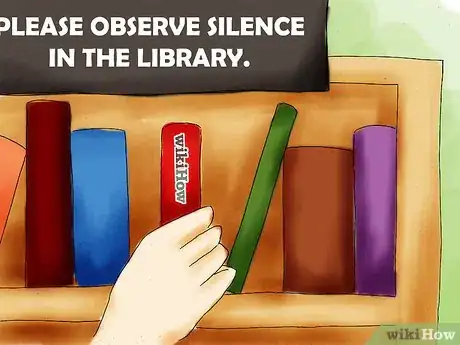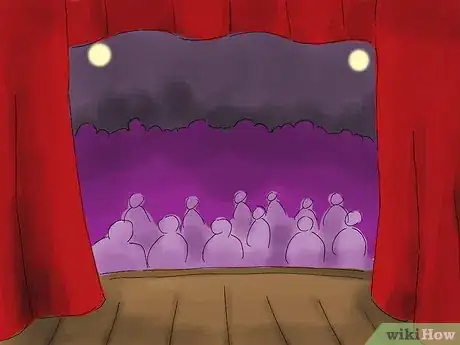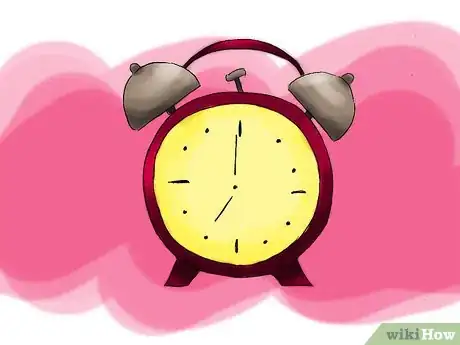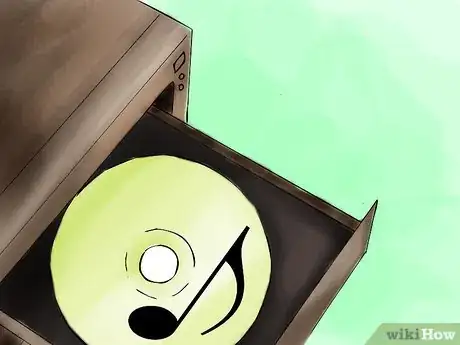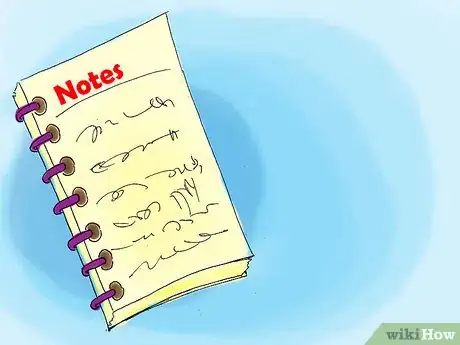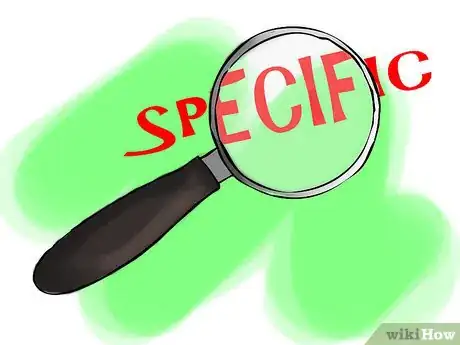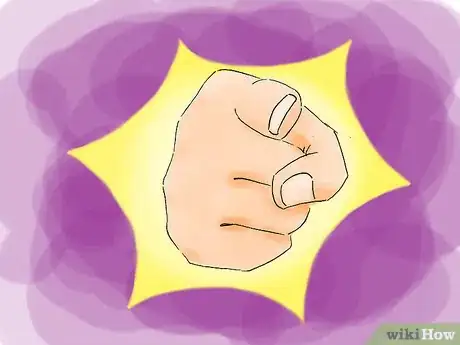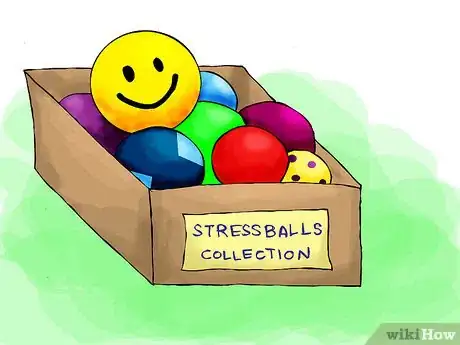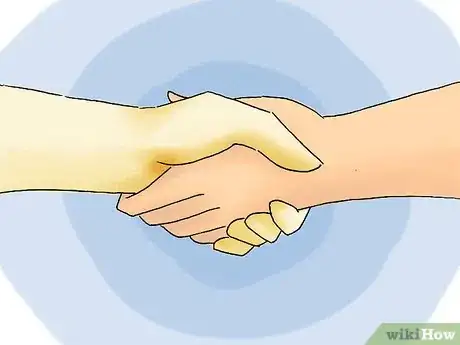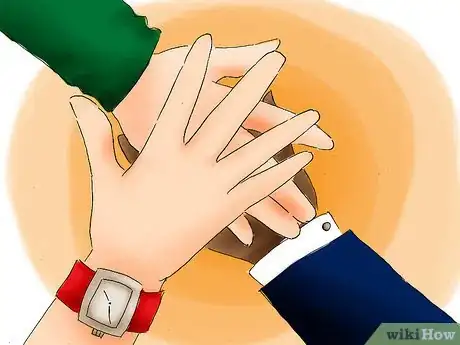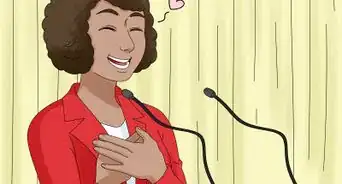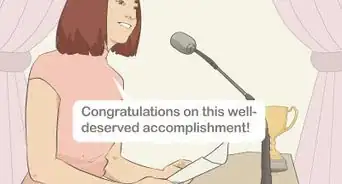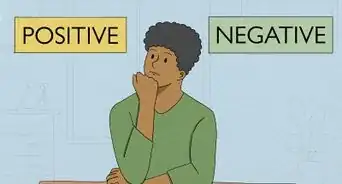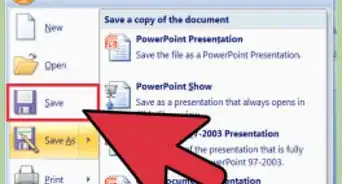wikiHow is a “wiki,” similar to Wikipedia, which means that many of our articles are co-written by multiple authors. To create this article, 15 people, some anonymous, worked to edit and improve it over time.
wikiHow marks an article as reader-approved once it receives enough positive feedback. This article received 15 testimonials and 89% of readers who voted found it helpful, earning it our reader-approved status.
This article has been viewed 269,807 times.
Learn more...
Even the person with the worst stage fright in the world can improve their presentation skills. In fact, many amazing presenters are horribly nervous before they begin their big talk. To improve your presentation skills, all you have to do is learn to relax, have confidence in what you have to say, and follow a few tricks to connect with your audience. It takes time and patience to improve your presentation skills, but if you set your mind to it, you'll be wowing audiences and getting your point across effectively in no time.
Steps
Planning for Success
-
1Do your research. If you want to have stellar presentation skills, then you have to sound like an expert on the subject you're speaking about, whether it's the mating pattern of sea otters or the inexplicable popularity of Miley Cyrus. Though having a degree or lots of experience in the field can help convince your audience, researching the topic as thoroughly as you can is your best bet for making them believe every single word you say.
- Hit the Internet and library and talk to experts to get a better idea of your subject, until you feel that you can effectively give a presentation on your subject and answer any questions that will arise along the way.
- The more research you do, the more confident you'll be about giving your presentation. And if you're more confident, you'll be better at giving your presentation.
-
2Know your audience. If you want to polish your presentation skills, then you have to give a lot of thought to who will be in the audience. If you know you'll be presenting to your fellow classmates, then you have to think about what will intrigue and interest them. If you're presenting your topic to a group of specialists, then you can assume they know the lingo; if you're presenting a complicated topic to a group of eighth graders, however, then you'll have to simplify it so they can follow along.
- Though you can't know everything your audience will and will not want to know, you can figure out a lot based on the age and the make-up of the group of people you'll be presenting to. Keep this in mind as you hone your presentation.
Advertisement -
3Make a plan for your time limit. Chances are that you have a certain time limit for giving your presentation, whether it's half an hour for a work presentation or ten minutes for a presentation in class. Whatever your time limit is, you should make your presentation so it fits comfortably under the time limit so you don't spend your time talking too fast to try to hit every point; however, you shouldn't make it so much shorter that you're left with a lot of "dead time" at the end.
- The closer your presentation is to meeting that time limit, the more relaxed you'll be about presenting your material, and the better your presentation skills will be.
-
4Consider using technology. Technology, from using music or a slide projector, can help enhance your points and engage your audience. However, having too much technology can have the opposite effect -- they call it "Death by PowerPoint" for a reason. So, if you do decide to use technology, make sure that it helps you engage your audience and to have stronger, more confident presentation skills instead of alienating your audience.
- It can be easy to use technology as a crutch. You may feel less prepared and skilled if you're depending on a machine to do some of the work for you. However, if you think having some charts, graphs, or bullet-pointed arguments will be really helpful for making your point, then by all means go for it.
-
5Have a solid presentation structure. A logical and well-organized presentation structure will help you improve your skills because all of your work will be laid out for you. Though you can have room for creativity when creating a presentation, most presentations, just like most essays, typically follow a similar structure. Here's how it should look:[1]
- Introduction: Hooking your your audience and introducing the main points you'll be making. In other words, "Tell 'em what you're gonna tell 'em."
- Body: Using specific examples, facts, stories, and data to help illustrate your point. In essence, "Tell 'em." Restate your most important points to make sure they resonate with your audience.
- Conclusion: Wrapping up your presentation with some food for thought while summarizing your main points. That is to say, "Tell 'em what you told 'em."
-
6Practice, practice, practice. If you want to improve your presentation skills, then one of the best things you can do is to practice your presentation. Practice it in front of the mirror, practice it in the shower, practice it in front of your close friends or family members. You should not, however, memorize it word for word, or your presentation will sound too rehearsed and you'll feel out of your element if you lose your place or are asked an unexpected question. Instead, you should practice it enough that you feel so comfortable with the subject matter that you can ad-lib a little.[2]
- You can film yourself giving the presentation if you think that will help you improve. However, some people actually get more nervous by doing this, so it's up to what you think is best.
Presenting with Confidence
-
1Relax beforehand. You can't go into a presentation sweating bullets or stuttering because you're so nervous that you can barely see straight. Instead, take a breather at least a few hours before a presentation, whether it means drinking a cup of camomile tea, meditating, or going for a walk. If you want to relax, then you have to prepare well in advance -- you won't be able to relax if you're perfecting and practicing your speech minutes before you have to present. Remember that the more relaxed you are, the easier it will be for your audience to connect to you, and the more fun you'll have.[3]
- Drink a tall glass of water to lubricate your vocal chords before you go on stage. Keep a glass or bottle of water with you on stage if it helps you relax and to pause occasionally.
- Arrive early to feel comfortable in the space where you'll be presenting. If you're presenting in an auditorium or another large building, then walk around the place or even sit in the audience to get a feel for it.
- If you want to help yourself relax, then remember that your aim is connection, not perfection. You want to connect with your audience instead of giving a bullet-proof presentation, and it's much easier to connect if you feel like you're being yourself.
-
2Exude confidence. Kill 'em with confidence before you even say your first word. If you look like you're confident about who you are and believe in what you're saying, then the audience will be much more likely to have faith in you. So, look sharp, have a big smile on your face, and make eye contact with your audience to show them that you're unafraid and know your stuff. Even if you're not feeling very confident, giving off confident vibes will help you feel at ease, and will make people more likely to believe in you.[4]
- Don't slouch. Keep your head high and your spine straight.
- Don't fidget or play with your hands. You can use your hands occasionally to gesture for emphasis, but don't do it too much or you'll look even more nervous.
- Be able to laugh at yourself. If you've made a little mistake, laugh it off and the crowd will laugh along with you instead of feeling awkward.
- Use forceful words and speak as if everything you say is a fact. Don't say, "I think that San Francisco may be a better city than LA" if the goal of your presentation is to prove that San Francisco is vastly superior to its southern cousin city; say, "San Francisco is a better city than LA, hands down," and your audience will be more likely to agree with you.
-
3Have a strong opening. You have to wow your audience from the get-go. If you have them hooked from the first word, then they'll be more likely to follow along the rest of the way. Start with a shocking or relevant fact, a funny and engaging anecdote, or with an inspiring quote. Whatever you start with, make sure that it's conducive to your presentation and isn't just there for the entertainment value.
- Whatever you do, do not apologize for having to give the presentation, even if it's a required presentation for work or school. Nothing will make your audience zone out faster than if you say, "Sorry to bore you guys with all this technical mumbo-jumbo, but I've gotta do it…"
-
4Be articulate. Being articulate is the key to improving your presentation skills. You can plan the most fascinating presentation of all time but your audience won't get a thing out of it if you're speaking too quietly or too fast or are rambling on so much that they don't get your main point. Focus on speaking clearly and slowly, and loudly enough for everyone to hear you. Let your expression match your words and people will be more likely to understand your words and to connect with you.
- Pause between sentences for emphasis, and work on eliminating as many "ums" and "uhs" as possible without freaking out if you use a few of them -- after all, even President Obama has been known to use a healthy dose of "ums" when getting his point across.
- Keep it concise. Work on trimming down any extra words and focus on what's important. You don't need a million adjectives to get your point across -- just one perfectly-chosen adjective will do.
- Read as much as you can to improve your knowledge base and vocabulary. This, in turn, will make you sound more intelligent and articulate.
-
5Get specific. If you want to fully articulate your points, then you'll need to use stories, anecdotes, statistics, and facts to support your ideas. If you tell your audience that a healthy diet is the key to a happy life but have no evidence to back it up, why should they believe you? Even if you're charming and funny, if there's no substance to your speech, your audience will be able to tell. Stories are a great way to create a human connection and to illustrate a point effectively without slowing down your momentum.
- You don't need a million facts and statistics, either; one or two carefully-chosen facts or statistics can really blow your audience away.
- A story or a statistic can be an effective, engaging way to open a presentation. You can also return to it at the end to wrap things up.
-
6Embrace the power of "you." Though you should avoid the second person when you're writing a formal essay, the word you is crucial to connecting to your audience during a presentation. You want to make each and every person feel that you're talking to them so that the person feels that your presentation can actually benefit them. You should say, "You can learn to manage conflict effectively in under an hour with five simple points," instead of "Any person can learn to manage conflict…" Though you're essentially saying the same thing, using you whenever it's appropriate will get your audience more involved in your presentation.
-
7Be human. Connect through your emotion. Nobody likes a boring speaker so infuse some energy into your gestures, inflect your voice as you would when talking to someone one-on-one, attempt self-deprecating humor and don't be afraid to show your failures as an example to learn from.
-
8Repeat your important points. Though every word in your presentation should count, undoubtedly there will be at least two or three points that you want your audience to walk away with. It's okay to remind your audience of these points by repeating them for emphasis; you can even do so without getting boring or repetitive. If you use a story or anecdote to illustrate a point, remind your audience of what the point is, and return to it later in your presentation, if not at the end. Let your audience see that some of the points you've made are more important than others.
- Another way to emphasize your important points is to slow down when you want your audience to really home in on your words. Use your hands to gesture for emphasis if it's necessary.
-
9Consider making time for a Q & A period. Having a question and answer period can help your audience really understand your material, connect with you and your presentation, and feel like they have gotten the full story on the subject you presented about. If you feel that your presentation calls for a question and answer period and that you can effectively make time for one without derailing your presentation, then you should plan for having a question and answer period after you've given the body of your presentation -- but before the closing.
- You should give a time limit for questions, say, 5-10 minutes. Tell your audience that you're going to make this much time for questions so that you don't get off track by answering so many questions that your audience has forgotten the gist or your presentation.
- Make sure you have a conclusion after the question period. You don't want to give a stellar presentation and then have it peter off into a series of irrelevant questions.
-
10Finish strong. End your presentation on a solid note. Don't let your presentation taper off or wrap things up when you or the audience looks bored. Give a firm conclusion that continues to engage your audience while reminding them about the most important points of the presentation. It's okay to "tell 'em what you told them," as a reminder about the central message of the presentation. Stay confident up until the very end, keep your head high, and even thank your audience for their participation if it's necessary.
- Avoid looking bored with your own presentation or eager to get off stage. Don't say something like, "Well, that about covers it," or "That's all I've got" -- be confident that you've given a great presentation and be excited about wrapping it up with a nice little bow.
Going the Extra Mile
-
1Get feedback. You can't just walk off the stage or away from the front of the room with a big grin on your face just because you feel like you nailed it. Even if you've given a stellar speech, there is always room for improvement, and you should look at every presentation that you give as a learning experience. And if you feel like you failed horribly, that's okay, too, and it means that you can learn even more from your experiences. Here are some great ways to get feedback:
- Have a trusted friend or co-worker sitting in the audience who can evaluate your work objectively. They can take notes on your confidence level, your articulateness, as well as the audience's reaction. You can even ask a few people to do this if you want more objective feedback.
- Pass out a questionnaire at the end of your presentation. Ask people to give you an honest analysis of how you did. Though taking criticism isn't always fun, it's an incredibly valuable tool.
- Consider taping yourself to see how you look on stage. How you felt during the presentation may not be a completely accurate representation of what the audience saw.
- Consider taping the audience. This can also help you gauge the audience's reactions, and will show which parts they thought were the most engaging, and which parts were the most boring or confusing.
- Check in with yourself. How do you feel that you did? Which parts did you struggle with the most? How can you learn from this presentation to make your next one even more stellar?
-
2Get inspired. Go see the best speakers in person and decide for yourself what makes them great. Why is Anthony Robbins a good or bad speaker? Is Steve Jobs inspiring? How does he deliver that inspiration through his presentation? How about MLK, FDR, or Winston Churchill? Watch other people give presentations or speeches and take notes. See what you can learn -- and what you can toss out. Seeing other people speak to large audiences can be inspiring and can make you feel like you too can accomplish this daunting task.
- Remember that even the speakers who look the most relaxed may suffer from horrible stage fright. With enough hard work, anyone can overcome that fear and look completely relaxed while being scared on the inside.
-
3Join a Toastmaster's organization. If you really want to improve your presentation skills, then joining a Toastmaster's organization can help you grow as a public speaker. You'll also meet interesting people, learn a variety of topics, and will learn to give articulate and exciting presentations in front of large audiences. If you want to succeed in public speaking for work, school, or just because it's something you love, then this is a wonderful option.[5]
-
4Take a seminar or course on public speaking. Another option is to take a course or seminar that can help you improve your public speaking skills. Your school or workplace may offer such courses, and they can be a great resource. You'll gain insight on what it means to give great public speeches from experts and will also be given the chance to practice in front of a relatively small audience. These courses will be small and supportive, and you'll feel less nervous about presenting since you know that everyone in the audience will also have to present at some point.
- If you want to improve your presentation skills, then taking a course in the subject will boost your abilities -- and your confidence.
Community Q&A
-
QuestionHow do I fit in time to practice? Should I stay up all night or wait until the morning?
 Community AnswerPractice well in advance of the night before or the morning of. The more practice you have done, the more muscle memory you will employ while speaking. Get a good night's sleep the evening before and run through your presentation once again the morning of.
Community AnswerPractice well in advance of the night before or the morning of. The more practice you have done, the more muscle memory you will employ while speaking. Get a good night's sleep the evening before and run through your presentation once again the morning of. -
QuestionHow do I end a presentation?
 Community AnswerEnd with something that connects back to your beginning or main topic of your presentation, a quote, a funny or common saying, or a thank you. Don't end with, "so yeah, that's all," or, "I'm done." The audience knows when you stop talking and will probably start applauding afterward.
Community AnswerEnd with something that connects back to your beginning or main topic of your presentation, a quote, a funny or common saying, or a thank you. Don't end with, "so yeah, that's all," or, "I'm done." The audience knows when you stop talking and will probably start applauding afterward. -
QuestionWhat is the definition of a presentation?
 Silvana HaynesCommunity AnswerIt refers to a speech or talk in which a new product, idea, or piece of work is shown and explained to an audience.
Silvana HaynesCommunity AnswerIt refers to a speech or talk in which a new product, idea, or piece of work is shown and explained to an audience.
References
- ↑ http://www.inc.com/guides/how-to-improve-your-presentation-skills.html
- ↑ http://www.inc.com/guides/how-to-improve-your-presentation-skills.html
- ↑ http://www.inc.com/guides/how-to-improve-your-presentation-skills.html
- ↑ http://www.forbes.com/2010/08/02/presentation-skills-public-speaking-communication-forbes-woman-leadership-career.html
- ↑ http://www.toastmasters.org
About This Article
If you want to improve your presentation skills, go for a walk, meditate, or distract yourself before your presentation so you don't get overly nervous. You should also drink a tall glass of water before you present to lubricate your vocal cords so your mouth doesn't feel dry. As you speak, try pausing for emphasis to avoid using filler words like "um" or "uh." To exude confidence, stand up straight and keep your shoulders back while you make eye contact with members of the audience. To learn how to plan your presentation so that it grabs your audience's attention, read on!

